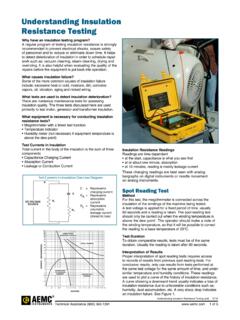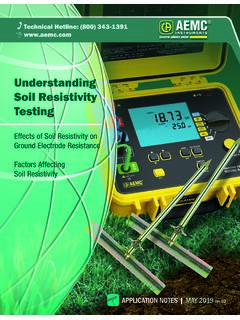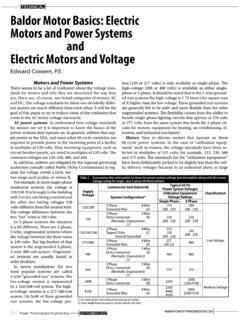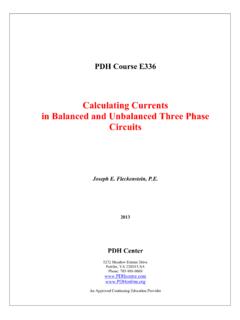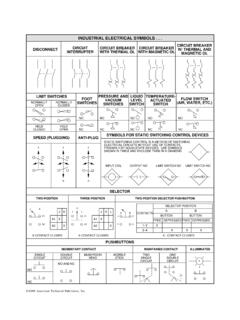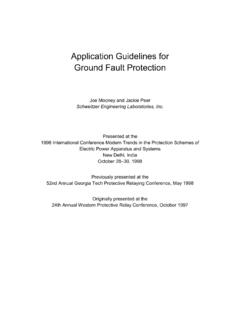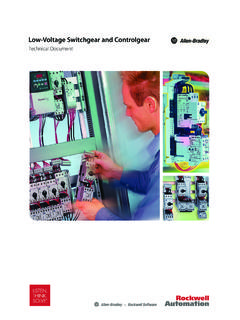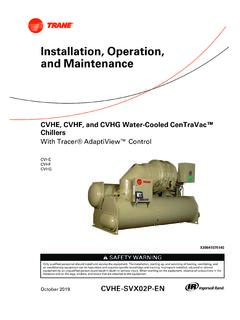Transcription of Three-Phase Dual-Voltage Motor Insulation Resistance …
1 Three-Phase Dual-Voltage Motor Insulation Resistance Testing Three-Phase dual - voltage motors are used for most day-to-day operations in today's industrial plants. These motors run conveyor belts, pumps, fans, and many other applications. Motors are susceptible to the gradual failure of their Insulation Resistance . The primary causes of Insulation failure include: electrical stress (current flow). mechanical stress (vibrations). chemical stress (corrosives). thermal stress (heating/cooling). environmental contamination (moisture/grime/oil). Monitoring Insulation Resistance over time can be a valuable tool in predicting when a Motor is headed toward failure and/or requires maintenance. A program of regularly scheduled Insulation testing with a megohmmeter can increase Motor safety by minimizing the risk of electric shock and electrical fire. Testing can also help manage Motor downtime. This Application Note reviews Insulation testing for three- phase Dual-Voltage motors. We look at different Motor types, methods for testing them, which megohmmeters to use for which types of testing, and questions to consider when setting up your own Insulation testing program.
2 Three-Phase Dual-Voltage Motor Primer Three-Phase dual - voltage motors come in three basic configurations: delta connected, 9-lead Wye (Y) connected, 9-lead Wye connected, 12-lead All three types can be wired for either 240 or 480 VAC. In addition, all three have six internal coils, although their internal connections differ widely. delta Connected, 9-Lead Motor This is probably the most common type of Motor in factories, lumber mills, and other industrial plants. These motors have nine leads, numbered to aid the electrician when connecting the Motor . To guide connection, the manufacturer's nameplate for this type of Motor typically contains information such as the following: L1 L2 L3 Join Low voltage 1,6,7 2,4,8 3,5,9 --- High voltage 1 2 3 4&7, 5&8, 6&9. According to the preceding table, for a high- voltage connection the electrician connects: L1 to lead 1. L2 to lead 2. L3 to lead 3. Wire-nut 4 and 7 together Wire-nut 5 and 8 together Wire-nut 6 and 9 together The following diagram illustrates these connections graphically: delta connected 9-lead wiring diagram In the preceding illustration, coils are identified by Roman numerals and leads by regular numbers.
3 Note that some coils are permanently connected (I to II, II to IV, and V to VI) and cannot be separated. This prevents testing coil-to-coil Insulation Resistance for all six coils and their combinations. To effectively test the Motor , you must disconnect the field coils where possible. To do this for delta connected 9-lead motors, remove the wire-nuts from 4 and 7, 5 and 8, and 6 and 9. This enables you to perform the following Insulation tests: Megohmmeter Megohmmeter + Insulation Resistance Connection Connection Tested Lead 1 Motor Frame Coils I & II to Frame Lead 2 Motor Frame Coils III & IV to Frame Lead 3 Motor Frame Coils V & VI to Frame Lead 1 Lead 2 Coils I & II to III & IV. Lead 1 Lead 3 Coils I & II to V & VI. Lead 2 Lead 3 Coils III & IV to V & VI. Wye Connected, 9-Lead Motor As with delta motors, the manufacturer's nameplate for wye connected 9-lead motors explains how the leads should be connected. The following table provides a typical example: L1 L2 L3 Join Low voltage 1,7 2,8 3,9 4&5&6.
4 High voltage 1 2 3 4&7, 5&8, 6&9. In this case, high- voltage connections are the same as for delta motors. The wiring diagram for a wye connected 9-lead Motor is as follows: Wye connected 9-lead wiring diagram Note that the wye-connected 9-lead Motor 's internal connections vary from the delta Motor . Coils II, III, and IV are permanently connected and cannot be separated. To properly test this type of Motor , remove the wire-nuts joining leads 4 and 7, 5 and 8, and 6. and 9. You can then perform the following Insulation Resistance tests: Megohmmeter Megohmmeter + Insulation Resistance Tested Connection Connection Lead 1 Motor Frame Coil I to Frame Lead 2 Motor Frame Coil VI to Frame Lead 3 Motor Frame Coil V to Frame Lead 7 Motor Frame Coils II, III, and IV to Frame Lead 1 Lead 2 Coils I to IV. Lead 1 Lead 3 Coils I to V. Lead 1 Lead 7 Coil I to II, III, and IV. Lead 2 Lead 3 Coil V to VI. Lead 2 Lead 7 Coil V to II, III, IV. Lead 3 Lead 7 Coil VI to II, III, IV. Wye Connected, 12-Lead Motor The manufacturer's nameplate for this type of Motor appears similar to the following: L1 L2 L3 Join Low voltage 1, 7 2, 8 3, 9 4&5&6, 10&11&12.
5 High voltage 1 2 3 4&7, 5&8, 6&9, 10&11&12. As this table shows, the connections required for a high- voltage connection are similar to those for delta and wye 9-lead motors. In addition, the 12-lead Motor requires connecting wire-nut 10, 11, and 12 together. The following diagram illustrates these connections graphically: Wye connected 12-lead wiring diagram Wye connected 12-lead motors differ from 9-lead Three-Phase Dual-Voltage motors in that none of the coils is permanently connected and therefore all can be tested separately. Although this increases the time required to test every possible combination; it does allow you to better pinpoint exactly where a failure may occur in the Motor . The following table lists the tests that can be performed on this Motor , after ensuring all wire-nuts joining leads are removed: Megohmmeter Megohmmeter + Insulation Resistance Tested Connection Connection Lead 1 Motor Frame Coil I to frame Lead 2 Motor Frame Coil VI to frame Lead 3 Motor Frame Coil V to frame Lead 7 Motor Frame Coil II to frame Lead 8 Motor Frame Coil IV to frame Lead 9 Motor Frame Coil III to frame Lead 1 Lead 2 Coils I to VI.
6 Lead 1 Lead 3 Coils I to V. Lead 1 Lead 7 Coils I to II. Lead 1 Lead 8 Coils I to IV. Lead 1 Lead 9 Coils I to III. Lead 2 Lead 3 Coils VI to V. Lead 2 Lead 7 Coils VI to II. Lead 2 Lead 8 Coils VI to IV. Lead 2 Lead 9 Coils VI to III. Lead 3 Lead 7 Coils V to II. Lead 3 Lead 8 Coils V to IV. Lead 3 Lead 9 Coils V to III. Lead 7 Lead 8 Coils II to IV. Lead 7 Lead 9 Coils II to III. Lead 8 Lead 9 Coils IV to III. Insulation Resistance Testing Methods There are several types of Insulation Resistance test in use today. Most can be classified as spot reading (short-time) tests, time- Resistance tests, or step voltage tests. Whichever test you choose, we recommend you measure Resistance both phase-to-phase and phase-to-frame if possible. Spot Reading Test This type of test is typically of very short duration (often 30 to 60 seconds). Spot reading tests are generally performed periodically and their results compared to identify possible trends. Note that this is a Resistance test, not to be confused with the pass/fail tests electricians often perform to test new installations for short-circuits.
7 One limitation of spot-reading is that all tests must be car ef ully normalized, since factors such as temperature ( Motor and air) and ambient humidity can affect and in some cases invalidate your measurements. Time- Resistance Tests A major advantage of time- Resistance tests is that they are fairly independent of temperature and humidity. They can also provide conclusive information without records of past tests. The test duration can be up to 10 minutes or longer depending on the size of the Motor . In general, good Insulation shows a continual increase in Resistance as test time increases. There are two time- Resistance tests that are used today: Polarization Index (PI) test is the most commonly used. It normally involves taking readings at 1 minute and 10 minutes. Other testing times are also sometimes used. Dielectric Absorption Ratio (DAR) test is no longer commonly performed, but may be useful for smaller motors. This test involves calculating the ratio of the Insulation Resistance measured after 60 seconds divided by the measurement at 30 seconds.
8 Step voltage Test The step voltage test creates electrical stresses on internal Insulation cracks, identifying potential problems that may not be revealed by testing at lower voltages. This involves testing at least two (and more often five) test voltages and comparing the results. The test begins at an initial test voltage . At a specified interval, typically one minute, a measurement is recorded, after which the test voltage is increased. This increase is usually to double the initial voltage for each step. This process may be repeated through several steps, with measurements taken after one minute and the test voltage increased at a two-to-one ratio over the previous voltage . Choosing a Megohmmeter AEMC Instruments offers a complete line of megohmmeters designed for Insulation testing, ranging from 100V handheld instruments to heavy-duty models providing test voltages up to 15,000V. And with some models, you can download and analyze the results on a computer running AEMC's DataView software.
9 AEMC megohmmeters are DC testers. The advantages of DC measurements i n c l u d e : Smaller and lighter instrument Non-destructive tests (will not damage Insulation ). Historical data accumulation and comparison Which megohmmeter to choose depends on several factors, including the instrument's: voltage range. The type of equipment to be tested determines this. As a general rule of thumb, the megohmmeter should be able to generate at least twice the equipment operating voltage . Resistance range. Consult the manufacturer of the equipment to be tested. On 3-phase motors, coil-to-coil resistances are in the 10M to 1000 M range, with coil-to-frame Resistance 10G +. Power source. Megohmmeter power can be supplied by hand-crank, battery, or line current. Hand-cranking instruments may not be practical for testing with long time durations. Insulation Resistance Testing FAQs At what voltage should I test my equipment? The general rule of thumb is to test at 2x the boiler plate rating up to 1000V.
10 Beyond 1000V, test at the normal operating voltage . My reading is (X). Is this good? Consult the manufacturer of the equipment under test for a definitive answer. How often should I test? For critical equipment we recommend monthly testing if possible. O t h e r e q u i p m e n t c a n be tested every 6 to 12 months during regularly scheduled shut-down. What's the difference between the M and k positions on megohmmeters? The M setting is for Insulation Resistance tests (high voltage /low current); k is for regular Resistance tests (low voltage /higher current). What kind of test should I perform on my Motor ? Generally the PI and step voltage tests are better suited for larger motors, while the DAR test and spot readings of 60 seconds or shorter are valuable for smaller motors. What is the purpose of the megohmmeter's built-in Voltmeter function? Safety. The megohmmeter itself is not dangerous; but the equipment under test may present a potential hazard. The Voltmeter function measures and displays any voltage on the equipment to be tested.
